 Before Pope Benedict XVI’s resignation, he agreed to allow a viewing of the Shroud of Turin to be broadcast live across the world on RAI, the state television channel, on March 30 in commemoration of Holy Saturday for the Year of Faith.
Before Pope Benedict XVI’s resignation, he agreed to allow a viewing of the Shroud of Turin to be broadcast live across the world on RAI, the state television channel, on March 30 in commemoration of Holy Saturday for the Year of Faith.
Now, I read today, Pope Francis has recorded a voice-over introduction for the broadcast. There is also an app called “Shroud 2.0” which enables people to explore the holy relic in detail on their smart phones and tablets.
Even more interesting is the release of a new book called The Mystery of the Shroud by Giulio Fanti, a professor of mechanical and thermal measurement at Padua University, and Saverio Gaeta, a journalist. According to their tests, the shroud dates from between the years 300 BC and 400 AD.
Holy Saturday is a day of anticipation. We ponder with gratitude the sacrifice of Our Lord who bore our sins on the Cross to redeem us from sin and death. And we await with joy and hope the Resurrection of our Lord on Easter Sunday. Forever will this day be linked in my mind to the image of the Shroud of Turin.
“The shroud, of course, reminds us of the passion, death and burial of the Lord, and then to Holy Friday, the day in which the Church remembers and celebrates the passion of Christ,” reflected Archbishop Cesare Nosiglia of Turin. “Holy Saturday is a day of silent prayer and meditation on the Lord’s death, but it is also a day of joyful waiting of the light of the Resurrection that will explode in the great celebration of the Easter vigil.” The shroud, he noted, “is a witness of this double mystery: It brings us back to the darkness of the tomb, but it also opens the way to receive the light that from it will emerge, in the event of the Resurrection.”
Pope Benedict gave a beautiful homily about Holy Saturday while on a visit to the Shroud in 2010. Here is an excerpt: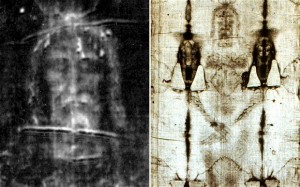
Holy Saturday is a “no man’s land” between the death and the Resurrection, but this “no man’s land” was entered by One, the Only One, who passed through it with the signs of His Passion for man’s sake: Passio Christi. Passio hominis (the Passion of Christ, the suffering of man).
….In this “time-beyond-time,” Jesus Christ “descended to the dead”. What do these words mean? They mean that God, having made Himself man, reached the point of entering man’s most extreme and absolute solitude, where not a ray of love enters, where total abandonment reigns without any word of comfort: “hell.”
Jesus Christ, by remaining in death, passed beyond the door of this ultimate solitude to lead us too to cross it with Him. We have all, at some point, felt the frightening sensation of abandonment, and that is what we fear most about death, just as when we were children we were afraid to be alone in the dark and could only be reassured by the presence of a person who loved us. Well, this is exactly what happened on Holy Saturday: the voice of God resounded in the realm of death. The unimaginable occurred: namely, Love penetrated “hell.” Even in the extreme darkness of the most absolute human loneliness we may hear a voice that calls us and find a hand that takes ours and leads us out.
Human beings live because they are loved and can love; and if love even penetrated the realm of death, then life also even reached there. In the hour of supreme solitude we shall never be alone: Passio Christi. Passio hominis.
 The latest issue of the Sisters of Life newsletter has an article about Cardinal John O’Connor, Archbishop of New York, talking to the sisters about a crisis of faith he had experienced many years ago. Excerpts of this hopeful message is very apropos for Good Friday.
The latest issue of the Sisters of Life newsletter has an article about Cardinal John O’Connor, Archbishop of New York, talking to the sisters about a crisis of faith he had experienced many years ago. Excerpts of this hopeful message is very apropos for Good Friday.
Many years ago,as a priest, I felt I had lost my faith. I was in Okinawa, many thousands of miles from home….I was the only priest, for thousands of men without families, without the ones they loved, torn by a thousand temptations….I would offer my Mass each day. I would hear confessions, I would preach. I would work, if anything, harder than usual.
Then the long night would come. I felt total emptiness, of Christ on the Cross: “My God, my God, why have you forsaken me?” I would go to my little tin hut chapel and there I would kneel in the darkness before the Blessed Sacrament in the tabernacle, in the glow of the little red tabernacle lamp. There, I would pray to what it was very difficult for me not to believe was but an empty tabernacle….It was an experience of extended, indescribable, terrifying desolation, of emptiness, of meaninglessness….While I had no sense of faith, and surely no sense of hope, I never completely lost the love of the Eucharist.
And the one day, as quickly as it came, the darkness and the desolation left and the glory of the Resurrection filled the totality of my being….I knew that I would never waver in faith or hope again.
There may be some who find it difficult to believe in the Eucharistic presence of Christ. Don’t try to believe. Just let yourself love and be loved by the Eucharistic Christ. When you receive Him in Holy Communion don’t ponder theological questions. Say, “This is my love. I have receive my love; my love has received me.”
Without love, there can be no joy. One could truly define the absence of joy as an absence of love, a failure to love. I felt no joy in Okinawa, and I felt no faith and felt no hope because I had suppressed love. The Love remained, the Love saved, the Love purified, but I had to let it become active again within me….I had to remember that the Eucharistic Christ is not simply the presence of Christ, but the presence of Christ who is love. And oh how I prayed through Mary, Mary, the womb of the Eucharistic Christ; Mary the womb of love!
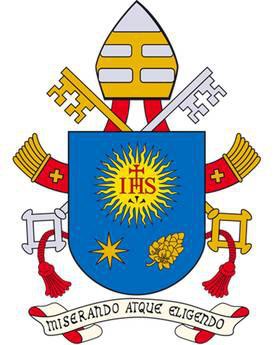
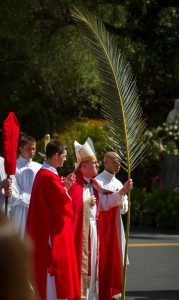 In this day and age when homogenization seems to rule the day, it is wonderful to know that there are some venerable orders like the Dominicans and the Carmelites who still retain their ancient liturgical practices. In particular, the Norbertine liturgy during Holy Week is replete with symbols which echo back to ancient practices. Saint Norbert lived around the time of the Crusades and since the Latin Catholic liturgy was the predominant from of worship in Jerusalem, the liturgical practices of the Church of the Holy Sepulchre in Jerusalem, the site of our Lord’s Crucifixion, Death and Resurrection, had a profound impact on the Norbertine liturgy.
In this day and age when homogenization seems to rule the day, it is wonderful to know that there are some venerable orders like the Dominicans and the Carmelites who still retain their ancient liturgical practices. In particular, the Norbertine liturgy during Holy Week is replete with symbols which echo back to ancient practices. Saint Norbert lived around the time of the Crusades and since the Latin Catholic liturgy was the predominant from of worship in Jerusalem, the liturgical practices of the Church of the Holy Sepulchre in Jerusalem, the site of our Lord’s Crucifixion, Death and Resurrection, had a profound impact on the Norbertine liturgy.
First, the Norbertines’ habit is white, like the original canons of the Church of the Holy Sepulchre, symbolizing the angels who announced the Lord’s Resurrection.
At the end of the Palm Sunday procession, there is an unveilng and a threefold adoration of the Holy Cross, a 12th century practice in the Church of the Holy Sepulchre.
On Good Friday, there is a special form of the unveiling and adoration of the Cross, symbolizing the Eastern and Western Churches uniting at the foot of Calvary.
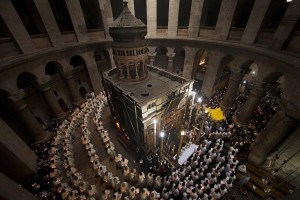
It is the tradition in the Holy Land to celebrate the Mass of the place versus the Mass of the day. So, for example, in Bethlehem, no matter what the day of the year (with some exceptions), the Mass celebrating the Lord’s birth is the order of the day. It is also true that in the Church of the Holy Sepulchre, the Easter Mass is usually celebrated every single day of the year. The Norbertines imitated this practice by celebrating the Mass of Easter each Sunday of Easter. At St. Michael’s Abbey in California, the Easter Antiphon of Easter Sunday is sung on each Sunday of the Easter season.
Finally, the Church calls for all the faithful to bow in reverence during the Nicene Creed when we recall the Incarnation. The Norbertines extend this reverence when the Nicene Creed is sung though the words professing faith in Jesus’ Burial and they rise from this reverence when they profess faith in His Resurrection. Once again, this practice comes from the Church of the Holy Sepulchre.
For more information, see the Spring 2013 issue of the St. Michael Messenger from St. Michael’s Abbey in Silverado, CA. If you are nearby a Norbertine Abbey, try attend a Norbertine liturgy and deepen your experience of Holy Week and the holy season of Easter. You don’t have to be a pilgrim to the Holy Land to experience a little bit of the uniqueness that comes from these ancient and deeply moving liturgical traditions.
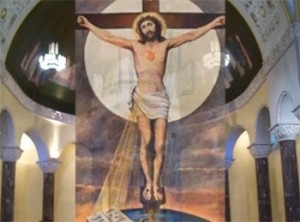 A review of the history and tradition of the Visitation Order shows that Jesus Christ chose them to be the sanctuary of His Sacred Heart. A new video released by them highlights six nuns who were holy recipients of His messages.
A review of the history and tradition of the Visitation Order shows that Jesus Christ chose them to be the sanctuary of His Sacred Heart. A new video released by them highlights six nuns who were holy recipients of His messages.
Of course, St. Margaret Mary Alacoque was the first privileged recipient of the revelation of the Sacred Heart of Jesus; a heart burning with love for all mankind whose hearts are often turned away from the Lord.
Venerable Sister Anne Madeleine Remuzat (b. 1696), of Marseilles, France, was instrumental in having the city of Marseilles consecrated to the Sacred Heart, which saved the city from the bubonic plague.
Sister Marie of the Sacred Heart Bernaud was Foundress of the Guard of Honor of the Sacred Heart of Jesus. The origin of the Guard of Honor may be traced back to the first watch on Calvary, when our Lady, St. John and St. Mary Magdalene offered to the pierced Heart of Jesus the first homage of glory, love and reparation. Members can still join today!
Venerable Mary Martha Chambon of the Visitation of Chambery (d. 1907), France was mystically commissioned by Jesus during her lifetime (1841-1907) to renew reverence to His Holy Wounds. St. Francis de Sales in a vision told her “God has chosen you to complete the devotion to the Sacred Heart.”
Venerable Louise Margaret Claret de la Touche was chosen by Our Lord to live her religious life for the clergy.
Sister Marie Teresa Desandais was a Visitation Nun known as the Apostle of Merciful Love and a contemporary of St. Faustina.
The Visitation Nuns hope that His Sacred Heart will profoundly touch yours too.
You know the times in which we live; they are scarcely less deplorable for the Christian religion than the worst days, which in time past were most full of misery to the Church. We see faith, the root of all the Christian virtues, lessening in many souls; we see charity growing cold; the young generation daily growing in depravity of morals and views; the Church of Jesus Christ attacked on every side by open force or by craft; a relentless war waged against the Sovereign Pontiff; and the very foundations of religion undermined with a boldness which waxes daily in intensity.
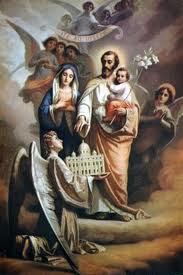
That God may be more favourable to Our prayers, and that He may come with bounty and promptitude to the aid of His Church, We judge it of deep utility for the Christian people, continually to invoke with great piety and trust, together with the Virgin-Mother of God, her chaste Spouse, the Blessed Joseph.
In giving Joseph the Blessed Virgin as spouse, God appointed him to be not only her life’s companion, the witness of her maidenhood, the protector of her honour, but also, by virtue of the conjugal tie, a participator in her sublime dignity. And Joseph shines among all mankind by the most august dignity, since by divine will, he was the guardian of the Son of God and reputed as His father among men. Hence it came about that the Word of God was humbly subject to Joseph, that He obeyed him, and that He rendered to him all those offices that children are bound to render to their parents.
And for such reasons, the Blessed Patriarch looks upon the multitude of Christians who make up the Church as confided specially to his trust – this limitless family spread over the earth, over which, because he is the spouse of Mary and the Father of Jesus Christ he holds, as it were, a paternal authority. It is, then, natural and worthy that as the Blessed Joseph ministered to all the needs of the family at Nazareth and girt it about with his protection, he should now cover with the cloak of his heavenly patronage and defend the Church of Jesus Christ.
Excerpted from Quamquam Pluries – ENCYCLICAL OF POPE LEO XIII ON DEVOTION TO ST. JOSEPH
“I am very happy that a Latin American has been elected. We know the hopes that it would have been someone from the continent that has the majority of Catholics [in the world],” were the first words of Fr. Federico Lombardi, S.J., director of the Holy See Press Office, commenting on the election of the new Pope to reporters.
“The choice of the name Francis is very meaningful,” he said. “It is a name that has never been chosen before and evokes simplicity and an evangelical witness. His first, simple appearance in public testifies to both. It is a sign of great spirituality to ask the people’s blessing for him before giving his own. It is a spirituality that recalls that of his predecessor. His pastoral sense of relationship with the Diocese of Rome should also be noted. It is the Pope’s diocese and [he chose] to pray the Church’s simplest prayers with the People of God at a moment like this.”
“Cardinal Bergoglio,” he added, “is a Jesuit. Jesuits are characterized by their service to the Church, collecting all the charisms that the Lord gives us wherever they are needed, but trying to avoid positions of power. For me this election takes on the meaning of a call to server, a strong call and not a quest for power or authority. I am absolutely convinced that we have a Pope who wants to serve. His election was the election of a rejection of power.”
Thanks to Vatican Information Service (13-3-2013) for providing this commentary. Click here to go to the Vatican website for a collage of pictures from that historic night.